Harry Coppock
Establishing Best Practices for Building Rigorous Agentic Benchmarks
Jul 03, 2025Abstract:Benchmarks are essential for quantitatively tracking progress in AI. As AI agents become increasingly capable, researchers and practitioners have introduced agentic benchmarks to evaluate agents on complex, real-world tasks. These benchmarks typically measure agent capabilities by evaluating task outcomes via specific reward designs. However, we show that many agentic benchmarks have issues task setup or reward design. For example, SWE-bench Verified uses insufficient test cases, while TAU-bench counts empty responses as successful. Such issues can lead to under- or overestimation agents' performance by up to 100% in relative terms. To make agentic evaluation rigorous, we introduce the Agentic Benchmark Checklist (ABC), a set of guidelines that we synthesized from our benchmark-building experience, a survey of best practices, and previously reported issues. When applied to CVE-Bench, a benchmark with a particularly complex evaluation design, ABC reduces the performance overestimation by 33%.
HiBayES: A Hierarchical Bayesian Modeling Framework for AI Evaluation Statistics
May 08, 2025Abstract:As Large Language Models (LLMs) and other AI systems evolve, robustly estimating their capabilities from inherently stochastic outputs while systematically quantifying uncertainty in these estimates becomes increasingly important. Further, advanced AI evaluations often have a nested hierarchical structure, exhibit high levels of complexity, and come with high costs in testing the most advanced AI systems. To address these challenges, we introduce HiBayES, a generalizable Hierarchical Bayesian modeling framework for AI Evaluation Statistics. HiBayES supports robust inferences in classical question-answer benchmarks and advanced agentic evaluations, particularly in low-data scenarios (e.g., < 20 data points per evaluation). Built on Generalized Linear Models (GLMs), Bayesian data analysis, and formal model comparison, HiBayES provides principled uncertainty quantification and robust parameter estimation. This paper offers a comprehensive introduction to HiBayES, including illustrative examples, comparisons to conventional statistical methods, and practical guidance for implementing multilevel Bayesian GLMs. Additionally, we provide a HiBayES software package [4] (Beta version) for out-of-the-box implementation.
Synthia's Melody: A Benchmark Framework for Unsupervised Domain Adaptation in Audio
Sep 26, 2023Abstract:Despite significant advancements in deep learning for vision and natural language, unsupervised domain adaptation in audio remains relatively unexplored. We, in part, attribute this to the lack of an appropriate benchmark dataset. To address this gap, we present Synthia's melody, a novel audio data generation framework capable of simulating an infinite variety of 4-second melodies with user-specified confounding structures characterised by musical keys, timbre, and loudness. Unlike existing datasets collected under observational settings, Synthia's melody is free of unobserved biases, ensuring the reproducibility and comparability of experiments. To showcase its utility, we generate two types of distribution shifts-domain shift and sample selection bias-and evaluate the performance of acoustic deep learning models under these shifts. Our evaluations reveal that Synthia's melody provides a robust testbed for examining the susceptibility of these models to varying levels of distribution shift.
Statistical Design and Analysis for Robust Machine Learning: A Case Study from COVID-19
Dec 15, 2022Abstract:Since early in the coronavirus disease 2019 (COVID-19) pandemic, there has been interest in using artificial intelligence methods to predict COVID-19 infection status based on vocal audio signals, for example cough recordings. However, existing studies have limitations in terms of data collection and of the assessment of the performances of the proposed predictive models. This paper rigorously assesses state-of-the-art machine learning techniques used to predict COVID-19 infection status based on vocal audio signals, using a dataset collected by the UK Health Security Agency. This dataset includes acoustic recordings and extensive study participant meta-data. We provide guidelines on testing the performance of methods to classify COVID-19 infection status based on acoustic features and we discuss how these can be extended more generally to the development and assessment of predictive methods based on public health datasets.
Audio-based AI classifiers show no evidence of improved COVID-19 screening over simple symptoms checkers
Dec 15, 2022



Abstract:Recent work has reported that AI classifiers trained on audio recordings can accurately predict severe acute respiratory syndrome coronavirus 2 (SARSCoV2) infection status. Here, we undertake a large scale study of audio-based deep learning classifiers, as part of the UK governments pandemic response. We collect and analyse a dataset of audio recordings from 67,842 individuals with linked metadata, including reverse transcription polymerase chain reaction (PCR) test outcomes, of whom 23,514 tested positive for SARS CoV 2. Subjects were recruited via the UK governments National Health Service Test-and-Trace programme and the REal-time Assessment of Community Transmission (REACT) randomised surveillance survey. In an unadjusted analysis of our dataset AI classifiers predict SARS-CoV-2 infection status with high accuracy (Receiver Operating Characteristic Area Under the Curve (ROCAUC) 0.846 [0.838, 0.854]) consistent with the findings of previous studies. However, after matching on measured confounders, such as age, gender, and self reported symptoms, our classifiers performance is much weaker (ROC-AUC 0.619 [0.594, 0.644]). Upon quantifying the utility of audio based classifiers in practical settings, we find them to be outperformed by simple predictive scores based on user reported symptoms.
A large-scale and PCR-referenced vocal audio dataset for COVID-19
Dec 15, 2022Abstract:The UK COVID-19 Vocal Audio Dataset is designed for the training and evaluation of machine learning models that classify SARS-CoV-2 infection status or associated respiratory symptoms using vocal audio. The UK Health Security Agency recruited voluntary participants through the national Test and Trace programme and the REACT-1 survey in England from March 2021 to March 2022, during dominant transmission of the Alpha and Delta SARS-CoV-2 variants and some Omicron variant sublineages. Audio recordings of volitional coughs, exhalations, and speech were collected in the 'Speak up to help beat coronavirus' digital survey alongside demographic, self-reported symptom and respiratory condition data, and linked to SARS-CoV-2 test results. The UK COVID-19 Vocal Audio Dataset represents the largest collection of SARS-CoV-2 PCR-referenced audio recordings to date. PCR results were linked to 70,794 of 72,999 participants and 24,155 of 25,776 positive cases. Respiratory symptoms were reported by 45.62% of participants. This dataset has additional potential uses for bioacoustics research, with 11.30% participants reporting asthma, and 27.20% with linked influenza PCR test results.
Audio Barlow Twins: Self-Supervised Audio Representation Learning
Sep 28, 2022



Abstract:The Barlow Twins self-supervised learning objective requires neither negative samples or asymmetric learning updates, achieving results on a par with the current state-of-the-art within Computer Vision. As such, we present Audio Barlow Twins, a novel self-supervised audio representation learning approach, adapting Barlow Twins to the audio domain. We pre-train on the large-scale audio dataset AudioSet, and evaluate the quality of the learnt representations on 18 tasks from the HEAR 2021 Challenge, achieving results which outperform, or otherwise are on a par with, the current state-of-the-art for instance discrimination self-supervised learning approaches to audio representation learning. Code at https://github.com/jonahanton/SSL_audio.
The ACM Multimedia 2022 Computational Paralinguistics Challenge: Vocalisations, Stuttering, Activity, & Mosquitoes
May 13, 2022
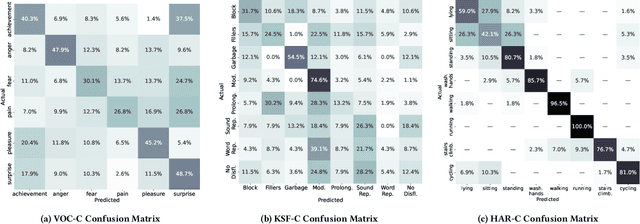

Abstract:The ACM Multimedia 2022 Computational Paralinguistics Challenge addresses four different problems for the first time in a research competition under well-defined conditions: In the Vocalisations and Stuttering Sub-Challenges, a classification on human non-verbal vocalisations and speech has to be made; the Activity Sub-Challenge aims at beyond-audio human activity recognition from smartwatch sensor data; and in the Mosquitoes Sub-Challenge, mosquitoes need to be detected. We describe the Sub-Challenges, baseline feature extraction, and classifiers based on the usual ComPaRE and BoAW features, the auDeep toolkit, and deep feature extraction from pre-trained CNNs using the DeepSpectRum toolkit; in addition, we add end-to-end sequential modelling, and a log-mel-128-BNN.
Climate Change & Computer Audition: A Call to Action and Overview on Audio Intelligence to Help Save the Planet
Mar 10, 2022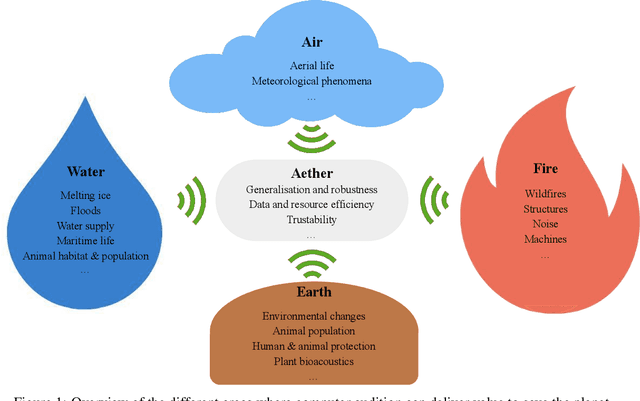
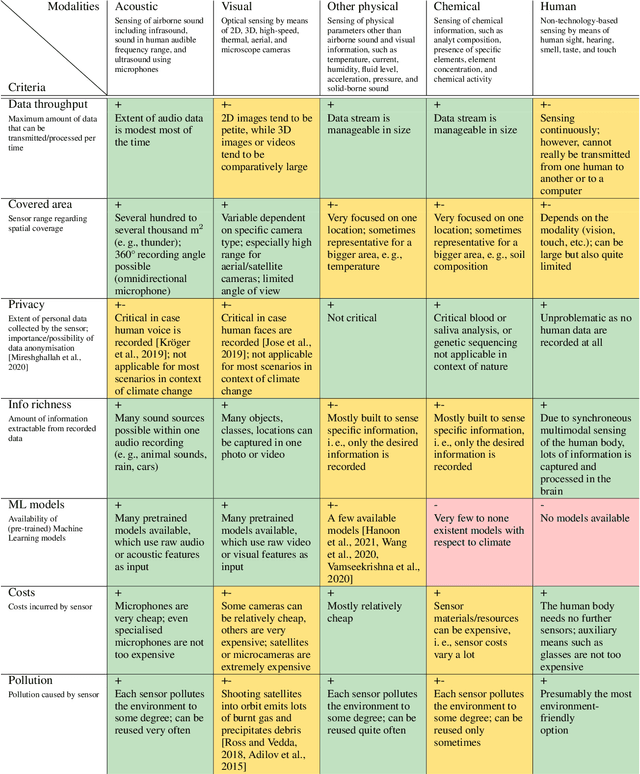

Abstract:Among the seventeen Sustainable Development Goals (SDGs) proposed within the 2030 Agenda and adopted by all the United Nations member states, the 13$^{th}$ SDG is a call for action to combat climate change for a better world. In this work, we provide an overview of areas in which audio intelligence -- a powerful but in this context so far hardly considered technology -- can contribute to overcome climate-related challenges. We categorise potential computer audition applications according to the five elements of earth, water, air, fire, and aether, proposed by the ancient Greeks in their five element theory; this categorisation serves as a framework to discuss computer audition in relation to different ecological aspects. Earth and water are concerned with the early detection of environmental changes and, thus, with the protection of humans and animals, as well as the monitoring of land and aquatic organisms. Aerial audio is used to monitor and obtain information about bird and insect populations. Furthermore, acoustic measures can deliver relevant information for the monitoring and forecasting of weather and other meteorological phenomena. The fourth considered element is fire. Due to the burning of fossil fuels, the resulting increase in CO$_2$ emissions and the associated rise in temperature, fire is used as a symbol for man-made climate change and in this context includes the monitoring of noise pollution, machines, as well as the early detection of wildfires. In all these areas, computer audition can help counteract climate change. Aether then corresponds to the technology itself that makes this possible. This work explores these areas and discusses potential applications, while positioning computer audition in relation to methodological alternatives.
A Summary of the ComParE COVID-19 Challenges
Feb 17, 2022
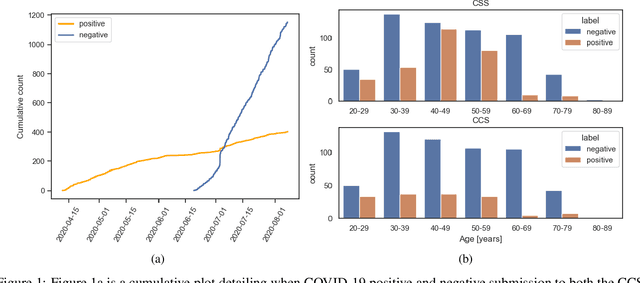
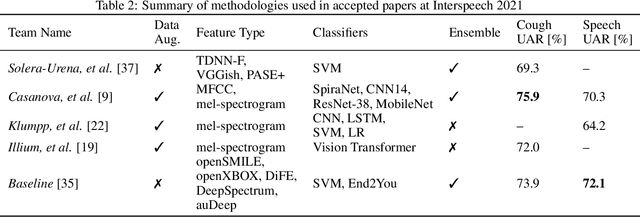
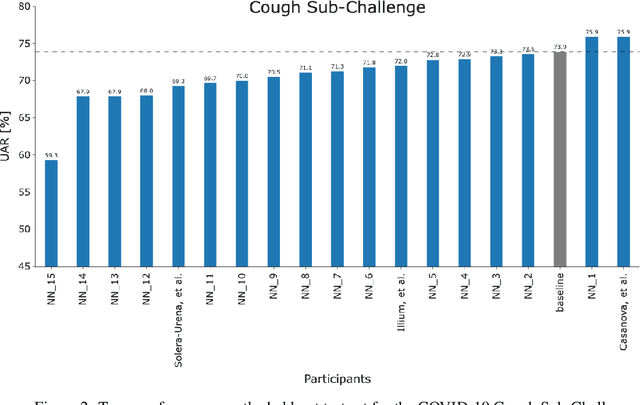
Abstract:The COVID-19 pandemic has caused massive humanitarian and economic damage. Teams of scientists from a broad range of disciplines have searched for methods to help governments and communities combat the disease. One avenue from the machine learning field which has been explored is the prospect of a digital mass test which can detect COVID-19 from infected individuals' respiratory sounds. We present a summary of the results from the INTERSPEECH 2021 Computational Paralinguistics Challenges: COVID-19 Cough, (CCS) and COVID-19 Speech, (CSS).
 Add to Chrome
Add to Chrome Add to Firefox
Add to Firefox Add to Edge
Add to Edge